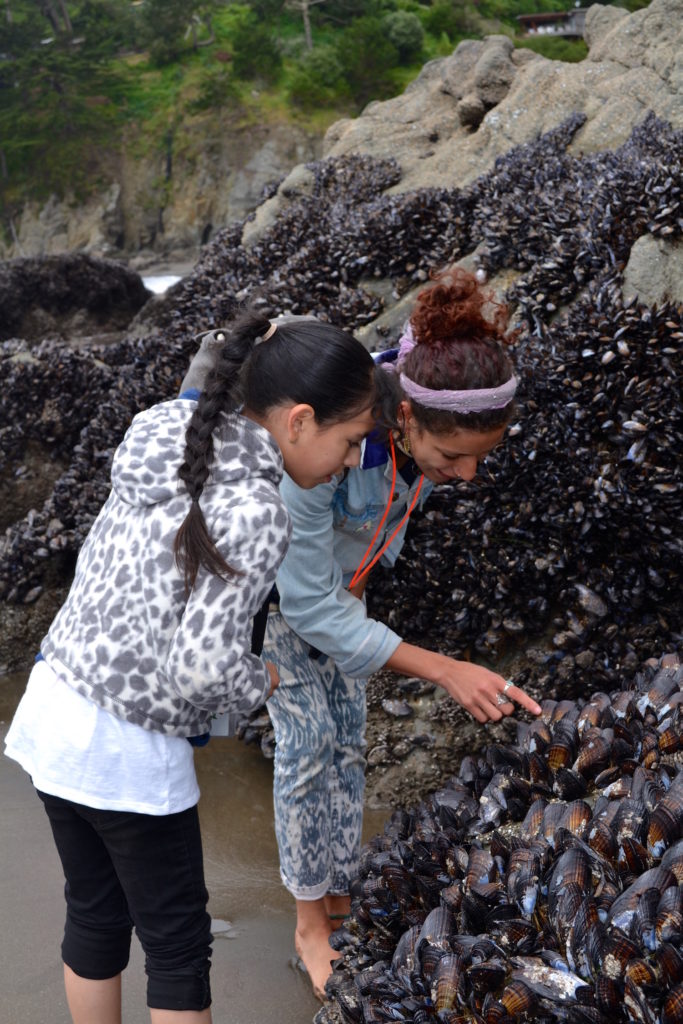Exploration and Discovery with KIDS for the BAY
July 27, 2016
“This is the most beautiful place ever!” exclaimed Emily, as she and her classmates climbed off the yellow school bus at Slide Ranch in Marin County. Their destination was an exciting KIDS for the BAY Field Trip – tide pooling at the Pacific Ocean! For Emily and her classmates, third graders from Community United Elementary School in East Oakland, this was a first time ever experience for many students to meet the ocean, discover bright green sea anemones, gently touch blue mussels and connect with nature in a truly unique environment.
As the students walked down the cliff to the rocky ocean shore, Rodolfo shared, “I really want to see a sea star.” Aniah added, “I hope we see crabs like the ones we saw in class!” Students quickly discovered limpets, barnacles, purple ochre sea stars and shoreline crabs. Jennali found a green sea anemone, “Oh wow, it’s amazing! It feels squishy and it’s blending into the rock,” she observed. Yahya was excited that he found a crab: “Look how fast it moves! What a cool animal!” Kei’Mora shared, “I never knew so many animals lived here! I will always remember them.”
An important focus of KIDS for the BAY is reducing plastic marine debris. Students were excited to clean up trash on the beach to help protect the animals they had just been studying. Emily explained, “We have to pick up the little pieces too, because animals eat trash without knowing that it’s trash! We can’t throw trash on the ground ever, because we know that the trash will end up in the ocean!” At the end of their Field Trip, the students were sad to leave Slide Ranch. “I just want to come back! I want to see this place again, it’s amazing,” said Erika. “This was a really special trip for all of us!” agreed Third Grade Teacher Mrs. Anh Nguyen Delos Reyes.

KIDS for the BAY students also learn about the problems of ocean acidification and how to reduce their carbon footprint. Community United Elementary students used scientific equipment to discover how water becomes more acidic when it absorbs carbon dioxide. Our young scientists tested the extent that egg shells dissolve in various acidic solutions, compared to tap water, a neutral solution. They made the connection that if the ocean becomes more acidic, organisms such as clams and other shellfish, with shells made out of calcium carbonate just like egg shells, may be in danger. “I think the acidic water would be bad for them,” said Saleh. To help reduce their carbon footprint, students volunteered to be energy conservation monitors in their classroom. Gary shared, “I’m excited to be door monitor because I’ll make sure that heat doesn’t escape through the open door and get wasted!”
Since 1992, KIDS for the BAY has engaged 73,097 school students and more than 8,000 parents in environmental education programs. We have provided curricula, resources, and training to 3,077 partner teachers. KIDS for the BAY programs engage elementary school students in academic enrichment and provide professional development for teachers to help them teach environmental science, both in the classroom and in the outdoors. Nature-based Field Trips, Classroom Lessons and Environmental Action Projects turn the local environment into a living laboratory for learning hands-on science and for taking action for the environment. Partner teachers especially appreciate that KIDS for the BAY curricula is aligned with Next Generation Science Standards and Common Core Standards.
In the 2015 – 2016 school year KIDS for the BAY took 25 teachers, 500 elementary school students and 120 parents on special ocean Field Trips. We are thankful to our Watershed Action – Coastal Connections program funders, California Coastal Conservancy-Explore The Coast and California Coastal Commission-Whale Tail Grants, who are helping to ensure that students like Emily, Saleh and their classmates have the chance to connect with the Pacific Ocean and become Inspired Environmentalists helping to take care of the marine environment we all share.







